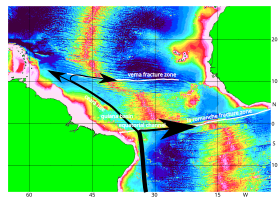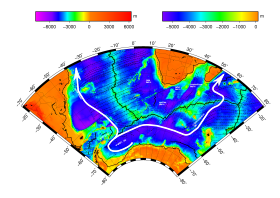Antarctic bottom water
The Antarctic bottom water (AABW) is a type of water mass in the Southern Ocean surrounding Antarctica with temperatures ranging from −0.8 to 2 °C (35 °F) and absolute salinities from 34.6 to 35.0 g/kg.[1] As the densest water mass of the oceans, AABW is found to occupy the depth range below 4000 m of all ocean basins that have a connection to the Southern Ocean at that level.[2] AABW forms the lower branch of the large-scale movement in the world's oceans through thermohaline circulation.
AABW forms near the surface in coastal polynyas along the coastline of Antarctica,[3] where high rates of sea ice formation during winter leads to the densification of the surface waters through brine rejection.[4] Since the water mass forms near the surface, it is responsible for the exchange of large quantities of heat and gases with the atmosphere.[5] AABW has a high oxygen content relative to the rest of the oceans' deep waters, but this depletes over time. This water sinks at four distinct regions around the margins of the continent and forms the AABW; this process leads to ventilation of the deep ocean, or abyssal ventilation.[6]
Formation and circulation
Antarctic bottom water is created is formed in the
A major source water for the formation of AABW is the warm offshore watermass known as the
Evidence indicates that Antarctic bottom water production through the Holocene (last 10,000 years) is not in a steady-state condition;

Atlantic Ocean
The Vema Channel, a deep trough in the
In the Guiana Basin, west of 40°W, the sloping topography and the strong, eastward flowing deep western boundary current might prevent the Antarctic bottom water from flowing west: thus it has to turn north at the eastern slope of the Ceará Rise. At 44°W, north of the Ceará Rise, Antarctic bottom water flows west in the interior of the basin. A large fraction of the Antarctic bottom water enters the eastern Atlantic through the Vema Fracture Zone.[21]

Indian Ocean
In the Indian Ocean, the Crozet-Kerguelen Gap allows Antarctic bottom water to move toward the equator. This northward movement amounts to 2.5 Sv. It takes the Antarctic Bottom Water 23 years to reach the Crozet-Kerguelen Gap.[22] South of Africa, Antarctic bottom water flows northwards through the Agulhas Basin and then east through the Agulhas Passage and over the southern margins of the Agulhas Plateau and then into the Mozambique Basin.[23]
Climate change
Climate change and the subsequent melting of the Southern ice sheet have slowed the formation of AABW, and this slowdown is likely to continue. A complete shutdown of AABW formation is possible as soon as 2050.[24] This shutdown would have dramatic effects on ocean circulation and global weather patterns.[citation needed]
Potential for AABW Disruption
Increased intrusion of warm Circumpolar Deep Water coupled with enhanced ice shelf basal melting can impact the formation of dense shelf waters.[25] For surface water to become deep water, it must be very cold and saline. Much of the deep-water formation comes from brine rejection, where the water deposited is extremely saline and cold, making it extremely dense. The increased ice melt that occurred starting in the early 2000s has created a period of fresher water between 2011-2015 within the bottom water.[26] This has been distinctly prevalent in Antarctic bottom waters near West Antarctica, primarily in the Weddell Sea area.[26]
While the freshening of the AABW has corrected itself over the past few years[when?] with a decrease in ice melt, the potential for more ice melt in the future still poses a threat.[26] With the potential increase in ice melt at extreme-enough levels, it can have a serious impact on the ability for deep sea water to be formed. While this would create a slowdown referenced above, it may also create additional warming. Increased stratification coming from the fresher and warmer waters will reduce bottom and deep-water circulation and increase warm water flows around Antarctica.[25] The sustained warmer surface waters would only increase the level of ice melt, stratification, and the slowdown of the AABW circulation and formation. Additionally, without the presence of those colder waters producing brine rejection which deposits to the AABW, there may eventually be no formation of bottom water around Antarctica anymore.[25] This would impact more than Antarctica, as AABW plays a major role in bottom water formation and deep-sea circulation, which deposits oxygen to the deep sea and is a major carbon sink. Without these connections, the deep sea will become drastically changed with the potential for collapse in entire deep-sea communities.[25]
Some studies indicate that WSBW formation in the Weddell Sea is dominantly driven by wind-driven sea ice changes, however, and that increased sea ice formation overcompensates for the melting of ice sheets, rendering the effects of melting Antarctic glaciers on WSBW minimal.[27]
References
- S2CID 259468175.
- ^ "AMS Glossary of Meteorology, Antarctic Bottom Water". American Meteorological Society. Retrieved 29 June 2023.
- ISSN 2169-9275.
- ISSN 1752-0908.
- ISSN 0148-0227.
- .
- ISBN 0-87590-095-X.
- .
- ISSN 0094-8276.
- ISSN 2169-9275.
- PMID 32494658.
- PMID 27552365.
- ISSN 2169-9275.
- ISSN 0094-8276.
- ISSN 1758-6798.
- .
- PMID 21245840.
- .
- .
- ^ "AMS Glossary, Vema Channel". American Meteorological Society. Retrieved 2012-02-20.[permanent dead link]
- ^ . Retrieved 2012-02-14.
- .
- . Retrieved 1 April 2015.
- S2CID 9410444.
- ^ a b c d Silvano, A., Rintoul, S. R., Peña-Molino, B., Hobbs, W. R., van Wijk, E., Aoki, S., ... & Williams, G. D. (2018). Freshening by glacial meltwater enhances the melting of ice shelves and reduces the formation of Antarctic Bottom Water. Science advances, 4(4), eaap9467.
- ^ a b c Aoki, S., Yamazaki, K., Hirano, D., Katsumata, K., Shimada, K., Kitade, Y., ... & Murase, H. (2020). Reversal of freshening trend of Antarctic Bottom Water in the Australian-Antarctic Basin during 2010s. Scientific reports, 10(1), 1-7.
- ISSN 1758-6798.
- Glossary of Physical Oceanography
- Steele, John H., Steve A. Thorpe and Karl K. Turekian, editors, Ocean Currents: A derivative of the Encyclopedia of Ocean Sciences, Academic Press, 1st ed., 2010 ISBN 978-0-08-096486-7
- Seabrooke, James M.; Hufford, Gary L.; Elder, Robert B. (1971). "Formation of Antarctic Bottom Water in the Weddell Sea". Journal of Geophysical Research. 76 (9): 2164–2178. .
- Fahrbach, E.; Rohardt, G.; Scheele, N.; Schroder, M.; Strass, V.; Wisotzki, A. (1995). "Formation and discharge of deep and bottom water in the northwestern Weddell Sea". Journal of Marine Research. 53 (4): 515–538. .
